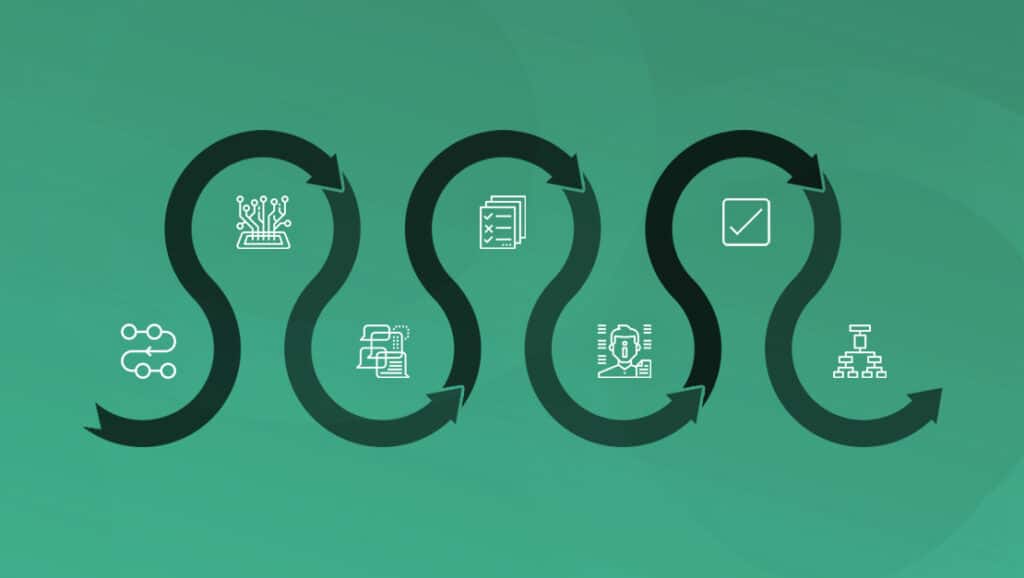You know the feeling– your work to-do list is running long and it feels like there isn’t enough time to get everything done. Workflow automation software can help you streamline your business processes, increase productivity levels, and reduce errors, all the while giving you more time in your day to execute the responsibilities that require human thought and strategic initiative.
We’re going to look at what automation workflow software is and how it can transform your operations and day-to-day activities.
What is Workflow Automation Software?
Workflow automation software is the use of technologies and systems to execute tasks and activities, with little to no human intervention (depending on the chosen solution).
As a tool, workflow automation software helps businesses and people to carry out key activities in less time with greater accuracy, all the while reducing or entirely removing repetitive and tedious manual labor.

Workflow Categories to Automate
Moving through a workflow from start to finish looks a bit different for each workflow in question, and it will entirely depend on how your process is designed.
That being said, there are three categories of workflows to consider automating, namely:
Sequential
As the name implies, sequential workflows move from one step the next in sequence, without going backwards. Typically, each subsequent step will depend on the one prior.
Parallel
Parallel activities can take place simultaneously as they do not depend on one another.
State Machine
State machine workflows are based on the state of the product and service at each stage of the process. If necessary, the process can revert backwards if need be.
Types of Workflow Automation vs. Manual Workflows
Human resources are constrained by bandwidth and budget. Manual and traditional workflows are error-prone, tiring, and hard to standardize and control.
On the other hand, workflow automation software eliminates the challenges of manual workflows, and can be categorized as:
Robotic Process Automation (RPA)
Best suited for repetitive, data-driven, and back office tasks, robotic process automation uses software “bots” to mimic human workers.
Business Process Management (BPM) Software
Business process management is a broader umbrella that consists of robotic process automation and speech-enabled solutions within it.
Business process management software uses methods to discover, analyze, measure, and model entire business strategies and processes. It involves both the technological solutions and overall structure of how automation tools will be applied within an organization.
Benefits of Automation in Business Processes
You know the old adage “time is money.” No one will argue with the capability to get more done in less time, with fewer resources, right?
Streamlining business processes benefits your entire organization from top to bottom and internally to externally!
With workflow automation software, you have the power to:
Boost Efficiency
Workflow automation software provides faster processing and the ability to execute workflows 24/7, thereby increasing productivity and efficiency.
Reduce Errors and Risks
No matter how talented your team is, mistakes are inevitable. With workflow automation software, you gain utmost accuracy, resulting in fewer errors and less risks to your business.
Enhance Productivity
Since workflow automation software can execute processes without human intervention, you no longer have to worry about bottlenecks or processes getting stuck within the flow. Additionally, you can remove key person dependencies, so if someone is out of office, on vacation, or sick, your processes can continue forward.
Components of Workflow Automation Software
Workflow automation software is a mouthful to say, but it’s easier to implement and use than you may think. For most workflow automation software solutions, it will consist of:
-
Process Design
You begin by designing your process, without any need to change your current workflow (as long as there is no repetition or waste). When choosing your software, look for those that feature a drag-and-drop interface if you don’t want to rely on a dedicated IT team or coding knowledge.
-
Trigger Mechanisms
Then, you can set up your trigger mechanisms, which can be: event-based or time-based. This will move the process from one step to the next.
-
Integration Capabilities
Naturally, you’ll want your workflow automation software to be compatible with your existing tech stack and other software solutions. The best workflow automation software has integration capabilities through API connectors.
What Features to Look for in Workflow Automation Software
There are many different types of workflow automation software out there to choose from. On your journey of selection, there are some key features you’ll want to look out for, including:
- Task Automation and Assignment
- Task Dependencies
- Customizable Forms and Data Capture
- Data Validation and Verification
- Reporting and Analytics
- Real-time Monitoring
Where is Workflow Automation Well-Suited?
If you’re wondering, “Does workflow automation even work for my business?” The resounding answer is, “Yes (as long as you’re running processes)!”
Workflow automation software can be implemented in any type of industry, across any vertical because every business operates by way of completing processes.
And the chances are high that you have an array of processes taking place interminably. Workflow automation software is especially useful in:
- Manufacturing
- Production Workflow Automation
- Quality Control Processes
- Healthcare
- Patient Data Management
- Appointment Scheduling
- Finance
- Invoice Processing
- Expense Approval Workflows

How to Implement Workflow Automation Software
To capture the benefits of workflow automation software, you have to simply get started. Then, the array of benefits and ROI will quickly be recognized.
To do so, follow these steps:
-
Assess Current Processes
Take stock of your current processes. Assess your business goals and the gap between where you are and where you want to be.
-
Customize and Configure
With the aid of process mapping, you can visualize your existing processes. Then, it’s time to eliminate any that aren’t needed, redesign those that are ripe for process improvement, and keep any that are properly structured as is.
-
Focus on Change Management
It’s really critical to have everyone on board with the use of workflow automation software to make it work to its fullest potential. This will involve adequate communication and the involvement of your entire team, stakeholders, and management. It’s natural for people to feel resistant to change, especially when it involves technology. Be sure to manage these sentiments and showcase the advantages of the workflow automation software as to augment your human resources, rather than be used to replace them.
-
Train Employees
Before deploying the workflow automation software and letting it do its thing, make sure to properly train employees so that they know how to use it. With the right tools, you can find easy-to-use interfaces, drag-and-drop capabilities, and supportive resources to quell any uneasiness that your team may feel.
What are Common Challenges and Solutions for Implementation?
Oftentimes, people get bogged down at the prospect of adding workflow automation systems within their business because of the common challenges that may be faced.
However, knowing the challenges in advance and finding the proper solutions can ease your fears.
Integration Challenges
Be sure that your chosen solution works well with your technologies, including legacy systems. This will help with data migration, as well, as you can connect all your existing information into one centralized location.
Security Concerns
Given that the workflow automation software will have access to your company and client data, security is a top priority. Workflow automation software should be equipped with top-tier security and the ability to keep it up-to-date over time. Encryption and data protection are a must.
Role-Based Access Control
Not everyone should be privy to the same information and sensitive data as it will depend on their role within your business. Access controls can be set based on position.
The Evolution, Growth, and Future Trends of Workflow Automation
Every year, the number of automated jobs increases by about 14%. And, rightfully so because workflow automation technology exponentially innovates with each passing day. With the aid of artificial intelligence, machine learning algorithms, predictive analytics, cloud-based workflow automation, and speech-enabled workflow automation, businesses are flocking to these solutions.
Workflow automation allows for businesses to scale with less resources, provides global accessibility and internal control, and supports increased collaboration between departments, teams, and geographic office locations.
Wrapping Up
Workflow automation software completely changes how you get things done without having to change your processes of how you get things done.
Let’s clarify what we mean– you can keep your existing workflows, apply your workflow automation software, and walk away. The system will do the work for you, with greater accuracy, efficiency, and ease than manual labor. To learn more about workflow automation and more specifically, speech-enabled workflow automation, we invite you to book a demo with aiOla so you can put your words to work.


